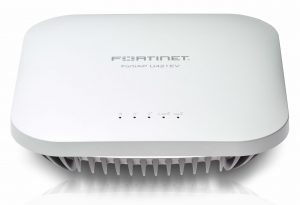Fortinet expands wireless access point portfolio with FortiAP
Fortinet, a provider of network security appliances and unified threat management solutions has announced the launch of its new FortiAP series of universal wireless access points (AP). The FortiAP claims to have been designed to reduce complexity and to be the most flexible, enterprise-grade wireless solution on the market. According to the company, Internet of Things (IoT) is secured through Secure Access, and with the expansion of its wireless suite, the new series of wireless access points provide essential solutions that are required to implement, manage, and grow an IoT-based access infrastructure.
The new solution is integrated within Fortinet Security Fabric that delivers combined protection for network along with security functions and application controls. Its Security Fabric integration also enables access network segmentation capabilities to deliver the only security strategy capable of protecting enterprises against threats targeting IoT and endpoint devices before they can access critical internal data.
John Maddison, Senior Vice President of Products and Solutions, Fortinet said:
 The company states that there is a need of security for IoT devices at the point of access as they cannot run a security client. The new FortiAP series wireless access points integrate advanced Security Fabric intelligence and protections, directly into the wireless infrastructure, that enables:
The company states that there is a need of security for IoT devices at the point of access as they cannot run a security client. The new FortiAP series wireless access points integrate advanced Security Fabric intelligence and protections, directly into the wireless infrastructure, that enables:
IT teams face severe challenges scaling and securing their wireless networks to meet rising access demands and the increasing dangers posed by IoT. The Fortinet Security Fabric solves these challenges by integrating security with the wireless infrastructure to unlock advanced internal segmentation strategies that are critical to defend against IoT threats.“Now offering automated operations and plug-in-play compatibility with any Fortinet access management backend, the introduction of Fortinet’s patented FortiAP series of universal access points lowers the barrier for customers to implement the increased security protections of the Fortinet Security Fabric,” adds Maddison.
 The company states that there is a need of security for IoT devices at the point of access as they cannot run a security client. The new FortiAP series wireless access points integrate advanced Security Fabric intelligence and protections, directly into the wireless infrastructure, that enables:
The company states that there is a need of security for IoT devices at the point of access as they cannot run a security client. The new FortiAP series wireless access points integrate advanced Security Fabric intelligence and protections, directly into the wireless infrastructure, that enables:
- Secure Access Control – FortiAP devices provide real time authentication and authorization of IoT devices to prevent such things as device spoofing, and to enable device tracking and traffic monitoring.
- Security Embedded in the Access Point – FortiAP devices can also be fully integrated with the Fortinet Security Fabric to deliver unified protections for the network edge through robust security functionality and application controls. This allows IT teams to easily implement essential Secure Fabric protections for their IoT technologies, and seamlessly integrate them into the unified security strategy deployed across the distributed network environment without compromising performance or functionality.
- Network Segmentation – The FortiAP series has been designed to provide dynamic access layer segmentation to better defend against emerging threats introduced by IoT devices and networks. By integrating FortiAP with the Security Fabric, organizations can dynamically route IoT traffic into its own secure network segment, thereby preventing an unauthorized user from monitoring or injecting malware into IoT traffic, as well as protecting the network from undetected or zero-day IoT malware.
- Specific Protection for IoT O/S vulnerabilities and exploits – Once IoT devices have been authenticated and segmented, the Security Fabric can accurately monitor IoT traffic, identify IoT-based threats, collect and share threat intelligence, and impose specific protections designed to address IoT-specific vulnerabilities and ferret out IoT exploits.
- Securing IoT Applications –It claims that the Fortinet Security Fabric is IoT-ready, it can identify and inspect IoT applications to detect unique threats targeted at IoT applications, devices, and traffic.
